Since arriving in Vancouver, I've realized that we are part of a "peer group" of international water cities. Through waterfront design conferences where the same cities seem to get invited time and time again, or through deeper and more interactive collegial opportunities for shared learning such as summits or study trips, these global water cities are taking every opportunity to learn from each other's successes and failures around water-edge planning and design.
Since arriving in Vancouver, I've realized that we are part of a "peer group" of international water cities. Through waterfront design conferences where the same cities seem to get invited time and time again, or through deeper and more interactive collegial opportunities for shared learning such as summits or study trips, these global water cities are taking every opportunity to learn from each other's successes and failures around water-edge planning and design.
Water provides so many advantages to a city, from port and industry, to tourism, recreation, sense-of-place and all-around city livability. Often there are tremendous challenges in prioritizing or balancing these many aspects of water city planning, particularly issues of port and industry economic viability vs. the attractiveness of mix-use redevelopment along the water. Another significant tension can involve public vs. private ownership of the water edge – It's wonderful when city and water are connected "by design", and painful when a city design has disconnected the public from the water.
Although countless cities have access to a water body of some sort (i.e. rivers, lakes, etc.) and are doing creative things to connect public life and neighbourhoods to the water edge, those cities with "big access to big water" such that it virtually defines their existence and sense of place, face particular opportunities and challenges (i.e. climate change and sea levels). Some of the most innovative, sustainable city-building in the world has been going on in these cities along the water edge.... and some not so good things as well.
In a series of blog posts (as time permits, so it may take a while), I'll try to summarize some key observations I've had from my trips and meetings with planners/designers/politicians in these water cities. My "to-do list" relative to such cities I've visited in the last few years include Sydney, Lisbon, Barcelona, Manchester, Oslo, Copenhagen, Rotterdam, Amsterdam, Malmo, Toronto, and New York.
So stay tuned. My intention is to focus on transferable lessons that are valuable for all cities connected to the water.
To start, it's interesting to note a few aspects of water city design that draw people to study Vancouver's success. In a nutshell, a few key principles have defined our downtown waterfront approach:
1. The water edge is always public. No building or use on the water is so important as to interrupt the continuous sea wall pathway along the water edge. Even the visual connection to the water is designed through streets that extend to the water edge and open views to the water that support the "mental map" of the city.
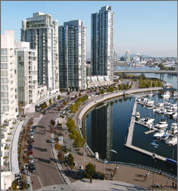

2. The building edge along the water, and the public realm design, is always intended to activate the space. We have residential door fronts, stores, community uses, etc, all enlivening and activating the sea wall edge. No blank walls.
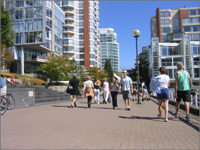
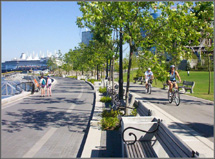
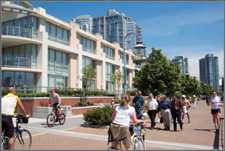
3. Mixed-use but highly residential neighbourhoods along the water-edge, that bring life to the water day and night. The housing is diverse with an emphasis on households with children, as places that are designed for kids tend to work for everyone.
4. The thinking is more about authentic neighbourhoods and public spaces, rather than the "destination development" approach that many cities are being sold, that lead to tourism based investments using global money. Tourists tend to love places that locals love, so if you design for locals, through authentic neighbourhoods, you can get places both locals and tourists love. Even our primary waterfront destination, Granville Island, is all about authenticity through retention of industrial uses, rough unfinished design, and local markets and artisans.
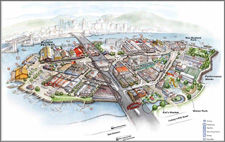
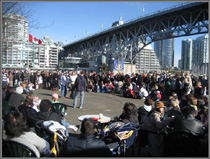
There's plenty more we could discuss about Vancouver, but I'll leave it at that, and look forward to using other cities to make other observations. As a shameless aside, if any sophisticated waterfront and downtown urbanists are interested in joining our team, note the search we have under way for our new Assistant Director of Planning - Central Area Planning.

Planetizen Federal Action Tracker
A weekly monitor of how Trump’s orders and actions are impacting planners and planning in America.

Maui's Vacation Rental Debate Turns Ugly
Verbal attacks, misinformation campaigns and fistfights plague a high-stakes debate to convert thousands of vacation rentals into long-term housing.

San Francisco Suspends Traffic Calming Amidst Record Deaths
Citing “a challenging fiscal landscape,” the city will cease the program on the heels of 42 traffic deaths, including 24 pedestrians.

Defunct Pittsburgh Power Plant to Become Residential Tower
A decommissioned steam heat plant will be redeveloped into almost 100 affordable housing units.

Trump Prompts Restructuring of Transportation Research Board in “Unprecedented Overreach”
The TRB has eliminated more than half of its committees including those focused on climate, equity, and cities.

Amtrak Rolls Out New Orleans to Alabama “Mardi Gras” Train
The new service will operate morning and evening departures between Mobile and New Orleans.
Urban Design for Planners 1: Software Tools
This six-course series explores essential urban design concepts using open source software and equips planners with the tools they need to participate fully in the urban design process.
Planning for Universal Design
Learn the tools for implementing Universal Design in planning regulations.
Heyer Gruel & Associates PA
JM Goldson LLC
Custer County Colorado
City of Camden Redevelopment Agency
City of Astoria
Transportation Research & Education Center (TREC) at Portland State University
Jefferson Parish Government
Camden Redevelopment Agency
City of Claremont



























